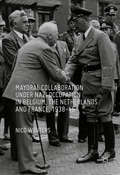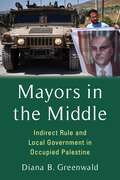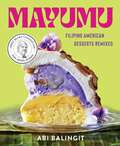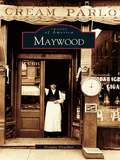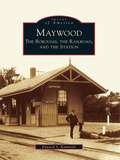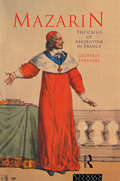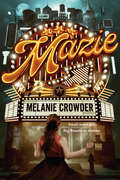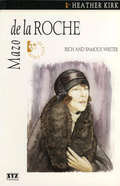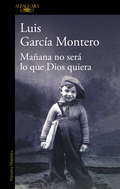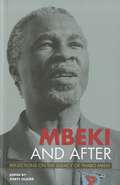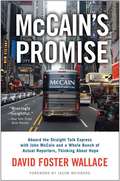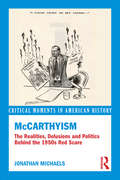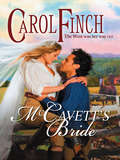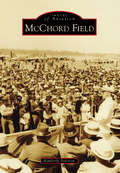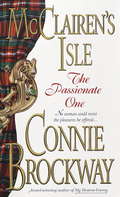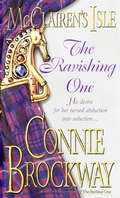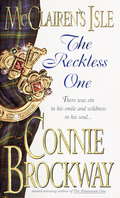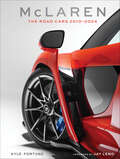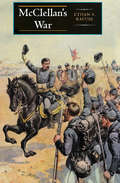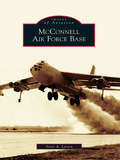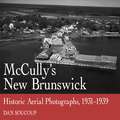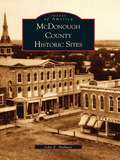- Table View
- List View
Mayoral Collaboration under Nazi Occupation in Belgium, the Netherlands and France, 1938-46
by Nico WoutersThis book explores the role of mayors in navigating the realities of living and governing under Nazi occupation. In Western Europe under Nazi occupation, mayors of villages and cities were forced into strategic cooperation with the occupier. Mayors had to provide good governance, mediate between occupier and populations, maintain personal legitimacy, and build local consensus. However, as national systems underwent authoritarian reform and collaborationists infiltrated administrations, local governments were gradually turned into instruments of Nazi control and repression. Nico Wouters uses rich new archival data to compare the realities of local government in three countries. Looking at topics such as food supply, public order and safety, forced labour, the repression of resistance, the persecution of the Jews and post-war purges, this book redefines our knowledge of collaboration, resistance and accommodation during Nazi occupation.
Mayors in the Middle: Indirect Rule and Local Government in Occupied Palestine (Columbia Studies in Middle East Politics)
by Diana B. GreenwaldWhat does local self-government look like in the absence of sovereignty? From the beginning of its occupation of the West Bank in 1967, Israel has experimented with different forms of rule. Since the 1990s, it has delegated certain governing responsibilities to the Palestinian Authority (PA), an organization that, Israel hoped, would act as a buffer between the military occupation and the Palestinian population.Through a historically informed, empirically nuanced analysis of towns and cities across the West Bank, Diana B. Greenwald offers a new theory of local government under indirect rule—a strategy that is often associated with imperial powers of the past but persists in settings of colonialism and state-building today. Grounded in fine-grained data on municipal governance under occupation as well as interviews with Palestinian mayors, council members, staff, activists, and political elites, this book traces how the Israel-PA regime has influenced the constraints and incentives of Palestinians serving in local government. Mayors in the Middle demonstrates that both the indirect rule system itself—as embodied in local policing arrangements—and the political affiliation of Palestinian mayors shape how politicians will govern. This variation, Greenwald argues, depends in part on whether local Palestinian governments are perceived as intermediaries within or opponents of the regime. Although Palestine is often treated as exceptional, Greenwald draws illustrative parallels with British colonial India and South Africa’s apartheid regime. A groundbreaking study of Palestinian local politics, Mayors in the Middle illuminates the broader dilemmas of indigenous self-government under systems of exclusion and domination.
Mayumu: Filipino American Desserts Remixed
by Abi BalingitNew York Time's "The Best Cookbooks of 2023" James Beard Award-winner for Emerging Voice 2024James Beard Award-nominee for Baking and Desserts 2024A sweet baking book of fantastically imaginative remixed Filipino American dessert recipes, plus essays on the Filipino American experience by baker-fundraiser Abi Balingit.When the pandemic started her lonely work-from-home life in 2020, Abi Balingit channeled all her energy into the one thing that brought her joy: baking. In her tiny, dimly lit, shared kitchen, she produced hundreds of “pasalubong” (souvenir) boxes filled with especially creative treats that blended the Filipino treats and Western style baked goods she grew up with. Each time, she’d sell out within hours and donated the proceeds to support her community in need.Now Abi shares some of these cult-favorite desserts with Mayumu (which means “sweet” in one of the 8 major languages in Philippines), an incredibly fresh baking book of 75 recipes that span from the never-before-seen, incredibly inventive flavor combinations that Abi dreamed up, to the more familiar, classic Filipino favorites: Adobo Chocolate Chip Cookie Strawberry Shortcake Sapin-Sapin (Rice Cakes)Ube Macapuno Molten Lava CakesMatcha PastillasMelon Chicharron CrumbleHalo-Halo Baked AlaskaThroughout, essays following Abi’s heritage and self-discovery introduce the flavors and experiences that have shaped her life, from visiting the motherland and her parents’ birthplace in Pampanga, Philippines, to California where she grew up and went to school, to her current home, Brooklyn, NY. This beautiful book is a celebration of the Filipino American experience, perfect for home bakers wanting both nostalgic and excitingly new recipes.
Maywood (Images of America)
by Douglas DeuchlerTen miles west of Chicago on the west bank of the Des Plaines River sits Maywood, a village that was founded in 1869 by seven New England businessmen who established the Maywood Land Company. This prairie community, carefully laid out along the railroad, experienced a population boom after the Great Chicago Fire of 1871. Soon industry arrived, followed by a variety of ethnic groups. Maywood was one of the few early suburban communities with an African-American neighborhood.
Maywood: The Borough, the Railroad, and the Station
by Edward S. KaminskiOriginally settled by Dutch farmers in the 1600s, the borough of Maywood experienced population and industrial growth in the late 1800s with the coming of the railroad. New Jersey Midland Railway, predecessor to the New York, Susquehanna and Western Railroad, arrived in 1872, a time when Maywood consisted mainly of farmland. Maywood was incorporated in 1894, when the railroad expanded into the Pennsylvania coalfields. The railroad provided the means for transportation of people, goods, and services, and Maywood grew measurably with it into the 20th century. Today the borough has developed into a suburb of such iconic cities as New York City, Paterson, Passaic, and Hackensack, while still retaining its character and charm.
Mazarin: The Crisis of Absolutism in France
by Geoffrey TreasureMazarin was the model statesman of the early modern period in French history. This book follows his career from pupil of the Jesuits, through legate in Paris and Avignon, to service for Louis XIII and beyond. Mazarin's role in the survival of absolute monarchy during the upheavals of the Fronde and his guidance of the young Louis XIV are given full weight. His crucial part in many diplomatic exchanges, and in particular those which brought an end to the Thirty Years War and the Franco-Spanish War, is examined in detail. His life is placed in the context of a study of the times, highlighting the rapidly changing nature of government.
Mazie
by Melanie Crowder*"Deserves a standing ovation." --Kirkus Reviews (starred review) *"The peppy first-person narrative keeps the story zipping along, and adroitly placed period details make the setting come alive in this bighearted, exuberant novel." --Publishers Weekly (starred review) An eighteen-year-old aspiring actress trades in starry Nebraska skies for the bright lights of 1950s Broadway in this show-stopping novel from award-winning author Melanie Crowder. Mazie has always longed to be on Broadway. But growing up in her small Nebraska town, that always seemed like an impossible dream. So when an opportunity presents itself to spend six weeks auditioning, Mazie jumps at the chance, leaving behind everything--and everyone--she's ever known.New York City is a shock to the senses: thrilling, but lonely. Auditions are brutal. Mazie's homesick and she misses the boyfriend whose heart she broke when she left. Nothing is as she expected.With money running out, and faced with too many rejections to count, Mazie is more determined than ever to land a role. But when she discovers that booking a job might mean losing sight of herself, everything Mazie always thought she wanted is called into question. Mazie is the story of a girl caught between two lives--and two loves--as she navigates who she is, what matters most, and the cost of following her dream. Praise for Mazie: "Entertaining and heartfelt."-- Booklist "Mazie&’s authenticity makes this novel stand out. Recommended for all collections, especially where theater is popular."– School Library Journal
Mazo de la Roche
by Heather KirkIn 1927, Mazo de la Roche was an impoverished writer in Toronto when she won a $10,000 prize from the American magazine Atlantic Monthly for her novel Jalna. The book became an immediate bestseller. In 1929, the sequel Whiteoaks also went to the top of bestseller lists. Mazo went on to publish 16 novels in the popular series about a Canadian family named Whiteoak, living in a house called Jalna. Her success allowed her to travel the world and to live in a mansion near Windsor Castle. Mazo created unforgettable characters who come to life for her readers, but she was secretive about her own life and tried to escape the public attention her fame brought.
Mañana no será lo que Dios quiera
by Luis García MonteroLa biografía novelada del genial poeta Ángel González, fruto del diálogo que mantuvo con el escritor y amigo Luis García Montero en sus últimos años de vida. El poeta Ángel González dejó una de las obras líricas más relevantes en lengua española, pero también fue testigo privilegiado de uno de los períodos más convulsos en la historia reciente de España: la Guerra Civil. Luis García Montero construye el retrato del poeta y recorre los primeros años de su vida para rescatar la mirada de un niño que tuvo que crecer sin la figura de su padre, pero con toda la fuerza de una familia y una geografía que se resistían con uñas y dientes a dejarse vencer. Mañana no será lo que Dios quiera es un homenaje a un territorio, a una familia, a los amigos y a los libros, que levantaron el espíritu del joven en ciernes que con el tiempo se transformaría en uno de los más grandes y premiados poetas de este país durante el siglo XX.Luis García Montero construye en Mañana no será lo que Dios quiera el retrato del poeta Ángel González. Una novela que pretende ser el testimonio de una realidad, escrita con humor, admiración y ternura. Reseñas:«La novela que me gustaría cantar. Una de las mejores canciones de amor que he leído. La historia de España vivida en primera persona.»Joaquín Sabina «Un relato hermoso y singular, la recuperación emocionante de la memoria de un niño de la guerra que habría de convertirse en uno de los grandes poetas españoles de la posguerra.»José Manuel Caballero Bonald «Un libro sorprendente que aúna la precisión de una biografía con el caudal narrativo de una novela. Un testimonio conmovedor y deslumbrante sobre un poeta, sobre una época, sobre la vida misma.»Felipe Benítez Reyes «Un relato hermoso y singular, una recuperación emocionante de la memoria de un niño de la guerra que habría de convertirse en uno de los grandes poetas españoles de la posguerra. Una novela, en definitiva, que pretende ser el testimonio de una realidad, escrita con humor, admiración y ternura.»Jurado del Premio de Librerías de Madrid
Mbeki and After: Reflections on the Legacy of Thabo Mbeki
by Daryl GlaserFor nearly ten years – indeed more if we include his period of influence under Mandela’s presidency – Thabo Mbeki bestrode South Africa’s political stage. Despite attempts by some in the new ANC leadership to airbrush out his role, there can be little doubt that Mbeki was a seminal figure in South Africa’s new democracy, one who left a huge mark in many fields, perhaps most controversially in state and party management, economic policy, public health intervention, foreign affairs and race relations. If we wish to understand the character and fate of post-1994 South Africa, we must therefore ask: What kind of political system, economy and society has the former President bequeathed to the government of Jacob Zuma and to the citizens of South Africa generally? This question is addressed head-on here by a diverse range of analysts, commentators and participants in the political process. Amongst the specific questions they seek to answer: What is Mbeki’s legacy for patterns of inclusion and exclusion based on race, class and gender? How, if at all, did his presidency reshape relations within the state, between the state and the ruling party and between the state and society? How did he reposition South Africa on the continent and in the world? This book will be of interest to anyone wishing to understand the current political landscape in South Africa, and Mbeki’s role in shaping it.
McCain’s Promise
by David Foster WallaceOne of our most brilliantly entertaining observers of American culture spends a week embedded in Senator John McCain's entourage - and indelibly captures the nonstop circus that is an American presidential campaign.
McCarthy and his Enemies: The Record and its Meaning
by L. Brent Bozell William F. Buckley Jr.Balanced analysis of McCarthy's career.
McCarthy: The Man, the Senator, and the Ism
by Jack Anderson Ronald MayDetailed study of the controversial Senator's life until 1952.
McCarthyism: The Realities, Delusions and Politics Behind the 1950s Red Scare (Critical Moments in American History #12)
by Jonathan MichaelsIn this succinct text, Jonathan Michaels examines the rise of anti-communist sentiment in the postwar United States, exploring the factors that facilitated McCarthyism and assessing the long-term effects on US politics and culture. McCarthyism:The Realities, Delusions and Politics Behind the 1950s Red Scare offers an analysis of the ways in which fear of communism manifested in daily American life, giving readers a rich understanding of this era of postwar American history. Including primary documents and a companion website, Michaels’ text presents a fully integrated picture of McCarthyism and the cultural climate of the United States in the aftermath of the Second World War.
McCavett's Bride
by Carol FinchUnable to tolerate the controlling expectations of her upper-class family, Pru Perkins shipped herself to Paradise, Oklahoma, as a mail-order bride. She was destined to make Jack's dreams of a peaceful life a distant memory!Ex-lawman Jack McCavett was done with excitement, glad to have his days of adventure behind him. Now he wanted to enjoy his quiet ranch with a restful, respectable woman at his side. But his special delivery was Pru, heiress, suffragette and all-round firebrand. Soon his desire for calm would be left far behind-and his need for Pru would be irresistible!
McChord Field (Images of Aviation)
by Kimberly PetersonMcChord Field, tucked away in the Pacific Northwest, maintains an understated presence. Yet this subdued outpost plays a vital role in major conflicts around the world. On July 3, 1940, McChord officially opened as a training base, developing bomber crews for aircraft such as B-17s, B-18s, B-25s, B26s, and even some of the Doolittle Raiders. Strategically located, McChord functioned as an aircraft modification center, producing P-39s, the Soviet Union's most venerable aircraft, as well as a homeland defense center during World War II. The dawning of the Cold War expanded air defense operations with the newly formed Air Defense Command, receiving the P-61, followed by the F-86, F-102, F-106, and F-15. A global airlift hub using C-124s, C-141s, and C-17s, McChord has supported humanitarian, Antarctic, and wartime missions for America.
McClairen's Isle: The Passionate One
by Connie BrockwayNo woman could resist the pleasures he offered....They are the Merricks, two brothers and a sister, restless, daring, proud. English by birth, they came to Scotland with their father to occupy McClairen lands. And there each would find a love as wild and glorious as the Highland isle they claimed as their own.Fia, the only daughter, is the ravishing one. Raine, the second son, is the reckless one. Ashton is the eldest son. This is his story. . . . The Passionate OneHe was a notorious rogue with a reputation for hell-raising and heartbreaking. But family secrets forced Ashton Merrick to do his ruthless father's bidding--and escort Rhiannon Russell back to McClairen's Isle. Ash suspected that his father intended to make the innocent beauty his fourth wife. But he didn't expect the passions she would ignite in his own wary heart.Watch for the next two books in the breathtakingly romantic McClairen's Isle trilogy, The Reckless One and The Ravishing One, coming soon from Dell.From the Paperback edition.
McClairen's Isle: The Ravishing One
by Connie BrockwayHis desire for her turned abduction into seduction....She is the toast of London society. But Fia Merrick gives her heart to no one, for love is a weakness she cannot afford. Once she would have given her soul to Thomas McClairen, until he shattered her innocent dreams. Now he is back, a convict returned to England in disguise to abduct Fia to Scotland, to McClairen's Isle. There, as Fia seeks her revenge in seduction, a passion is ignited that defies the past and cannot be denied....From the Paperback edition.
McClairen's Isle: The Reckless One
by Connie BrockwayRaine: The Reckless One...there was sin in his smile and wildness in his soul....Raine Merrick's wild, reckless spirit had earned him time in a French prison. When a mysterious beauty gains his freedom only to betray him, Raine Merrick sets out for his father's castle on McClairen's Isle, seeking the treasure hidden within. But strange surprises await him in the Highlands. He never expected to find his deceitful angel masquerading as an honored guest. Or to want her with all the searing passion in his sinner's soul.Watch for the crowning volume in the spellbinding McClairen's Isle trilogy, The Ravishing One, coming soon. And don't miss the first book in the trilogy, The Passionate One, available from Dell.From the Paperback edition.
McClellan's War: The Failure Of Moderation In The Struggle For The Union
by Ethan S. Rafuse&“An important book that rescues George B. McClellan&’s military reputation.&” —Chronicles Bold, brash, and full of ambition, George Brinton McClellan seemed destined for greatness when he assumed command of all the Union armies before he was 35. It was not to be. Ultimately deemed a failure on the battlefield by Abraham Lincoln, he was finally dismissed from command following the bloody battle of Antietam. To better understand this fascinating, however flawed, character, Ethan S. Rafuse considers the broad and complicated political climate of the earlier 19th Century. Rather than blaming McClellan for the Union&’s military losses, Rafuse attempts to understand his political thinking as it affected his wartime strategy. As a result, Rafuse sheds light not only on McClellan&’s conduct on the battlefields of 1861-62 but also on United States politics and culture in the years leading up to the Civil War. &“Any historian seriously interested in the period will come away from the book with useful material and a better understanding of George B. McClellan.&” —Journal of Southern History &“Exhaustively researched and lucidly written, Rafuse has done an excellent job in giving us a different perspective on &‘Little Mac.&’&” —Civil War History &“Rafuse&’s thoughtful study of Little Mac shows just how enthralling this complex and flawed individual continues to be.&” —Blue & Gray magazine
McConnell Air Force Base (Images of Aviation)
by Steve A. LarsenBeginning from its earliest days as an empty parcel of pasture that became a major hub airport for transcontinental air travel to its present use as the busiest refueling operation in the U.S. Air Force, the slice of land known as McConnell Air Force Base is inextricably connected to aviation to nearly the dawn of manned flight. Its military history began in 1941 with the arrival of the Air National Guard, and the base grew to a multifaceted operation that extends air power globally through intelligence and air refueling missions performed by its three partner units: the 22nd Air Refueling Wing, the 184th Intelligence Wing, and the 931st Air Refueling Group. This book offers a glimpse into the military history of McConnell Air Force Base through many rarely seen or previously unpublished images drawn primarily from the repository of the 22nd Air Refueling Wing Office of History and the Kansas Aviation Museum.
McCrae's Battalion: The Story of the 16th Royal Scots
by Jack AlexanderMcCrae's Own was the 'Heart of Midlothian Battalion' mentioned all too briefly in Martin Middlebrook's classic book The First Day on the Somme. Raised in Edinburgh shortly after the start of the Great War, it was perhaps the finest unit in Lord Kitchener's volunteer army - a brotherhood of sportsmen, bound together by their extraordinary colonel and their loyalty to a quaintly named Association Football club, the famous Gorgie 'Hearts'. McCrae's were blooded in the Battle of the Somme, losing three-quarters of their strength on the first day alone. The Colonel himself was invalided home. In time the battalion recovered. It came of age at Arras, endured the muddy horror of Passchendaele, and held the line unbroken in the face of furious German attacks on the Lys in 1918. For almost a century their story remained untold. It was all but lost forever. Now, after 12 years of exacting historical detective work, Jack Alexander has reclaimed the 16th Royal Scots for posterity. In this stirring book he draws upon interviews with veterans and a unique archive of letters, diaries and photographs, assembled from the families of more than 1,000 of Sir George McCrae's men.
McCully's New Brunswick: Photographs From the Air, 1931-1939
by Dan SoucoupDuring the Great Depression, promoter, salesman, and pilot Richard Thorne McCully became an aviation pioneer, capturing much of the Maritime region from the air. Along with photographer Harold Reid and pilot Marty Fraser, McCully spent the early 1930s flying over Atlantic Canada. The photographs they took offer a rare glimpse into prominent homes, vibrant businesses, churches, farms and waterfronts that are no longer standing or have been significantly altered. Each photo has been annotated with the natural features, architecture, streetscapes, industries, sporting events and other pastimes, and colourful characters depicted.These unique bird’s-eye views from 1931 to 1939 capture the feeling of that first day in May 1931 when McCully’s small twin-engine took off from the tiny Moncton airport.
McDonough County Historic Sites
by John E. HallwasMcDonough County Historic Sites depicts a remarkable agricultural region steeped in 19th-century tradition and community spirit. Originally set aside by Congress for veterans of the War of 1812 as part of the Illinois Military Tract, the land that is now McDonough County was settled by a diverse and ambitious population starting in the 1820s. From the trials of settlement to the coming of railroads and the establishment of small-town culture, McDonough County history reflects developments that have shaped America. The region's cemeteries, businesses, and homes that have endured-or vanished-offer stories of human endeavor that unite the people of the county to this day. The maps accompanying the chapters locate the county's many historic sites, such as the hotel in Macomb where Lincoln stayed during his 1858 campaign, the Prairie City Drugstore that launched a national poetry publishing company, and the remote village of Vishnu Springs that is now a ghost town. The historic images illustrate McDonough County's progress and controversy, small-town life and rural development, as well as religious diversity and cultural achievement.
